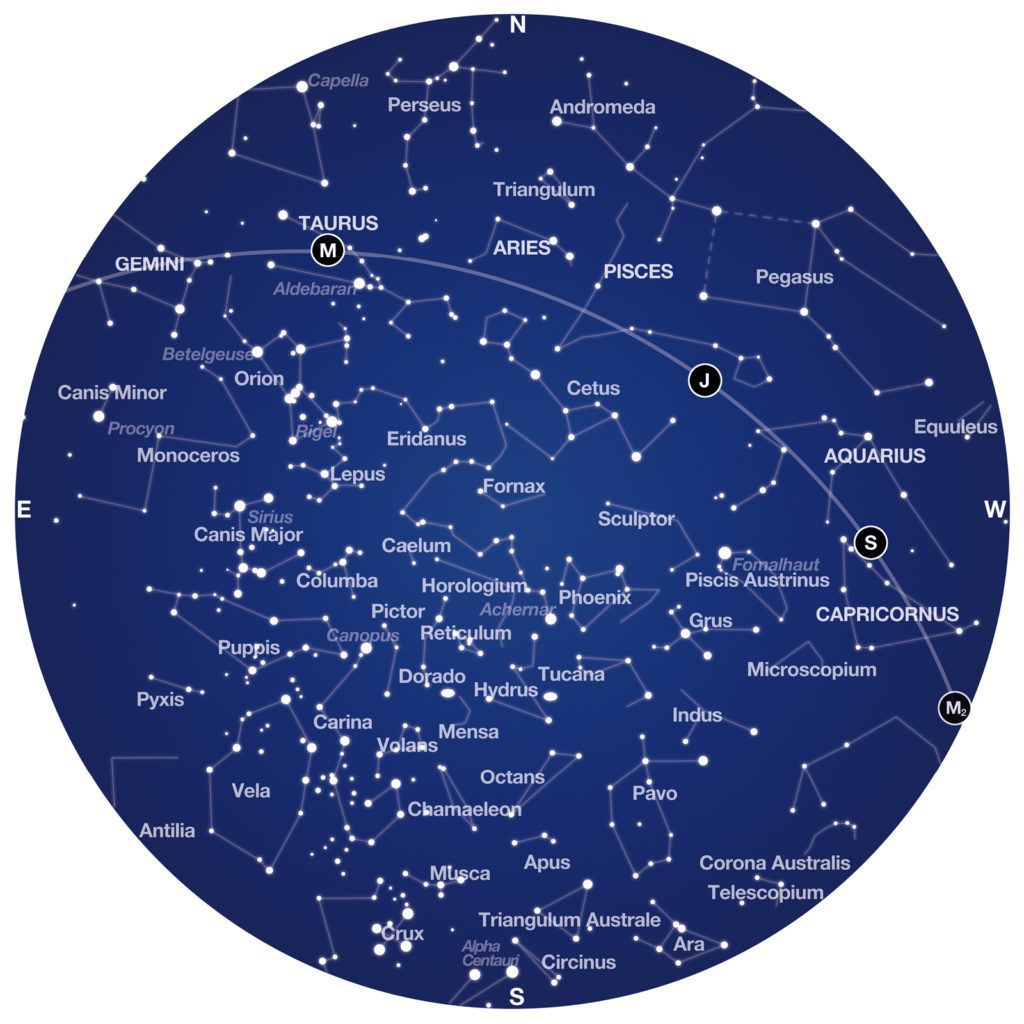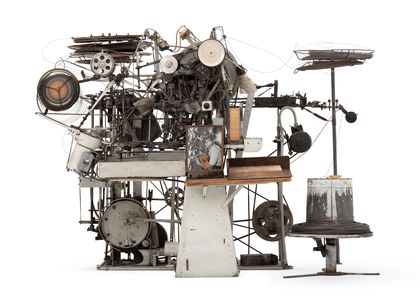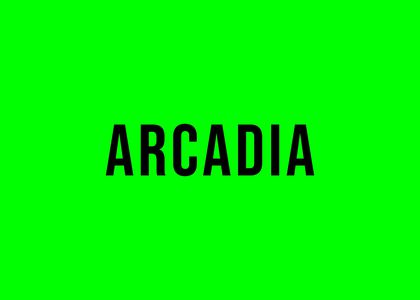
Monthly sky maps from the 2022 Australasian Sky Guide by Dr Nick Lomb, published by MAAS Media.
What’s in the sky this December?
Constellations
Constellations represent groups of stars that have been given a name and more recently a border. For millennia they have been used as a tool to share significant cultural stories. Today, the 88 western constellations used here help astronomers map the sky and search for astronomical objects. This December these constellations dominate the evening spring sky:
- Orion the hunter dominates the December north-eastern sky. One of the most famous non-zodiac constellations, its famous three-star belt lies close to the celestial equator. The middle starlike object in the sword that dangles from the belt, is a nebula or star making cloud around 1,350 light years away. It is so pretty and easy to find, that it is one of the first things new stargazers look at through a telescope. Known as M42 or the Orion nebula, it contains enough gas and dust to make as many as 2,000 stars like the Sun.
- Canis Major, the larger of Orion’s two hunting dogs, is to the east of Orion and hosts the brightest star in the night sky, Sirius at 8.6 light years.
- Taurus, the bull in the north, is possibly the oldest of all western constellations. It has one bright red dying star called Aldebaran. It also hosts the stunning open cluster M45 or the Pleiades, a group of young stars about 445 light years away. Below the horns is the remnant of a star that exploded as a supernova in 1054. It is now called M1, or the Crab nebula though a large telescope and clear northly view is needed for the best view.
- Eridanus the river– stretches high across the southern evening sky. One of Ptolemy’s original 48 constellations, it begins near the constellation of Orion and winds across the sky ending with the brilliant Achernar, a blue-white star shining at magnitude 0.5 that spins so quickly it is the least spherical star in the Milky Way galaxy.
- Pegasus – the winged horse is low in the north-west. With a clear view, it is easy to see as “The Great Square of Pegasus’. Generally lacking other bright stars, the square is easy to find and a good pointer to find just below, the most distant object visible to the unaided eye, the Andromeda galaxy, M31 at around 2.5million light years.
- Crux or the Southern Cross with its famous pointers of Alpha and Beta Centauri are conspicuous by their absence in the evening sky as they are low in the south-east making them hard to see. Light pollution and the thicker atmosphere near the horizon dim the starlight. If you must see these stars, wait until around 4am when they will be high in the southeast.
Planets
Five planets: Mercury, Venus, Mars, Jupiter, and Saturn can all be seen at various times this month. Watch how their positions change throughout the month as they travel along the ecliptic, the path they share with the Sun and Moon.
- Mercury, the innermost planet, will be at its best from 21 to 25 December low in the west after sunset in the constellation of Sagittarius. On 25 December, it will be above Venus and below the young (2.3day old) crescent Moon. Good weather and a clear westerly view will be needed to see all three.
- Venus – is low in the west in Sagittarius just after sunset. Throughout the month it sets later while at the same time it appears brighter.
- Mars – is in the constellation of Taurus all month and will be at opposition, with the Earth directly in between Mars and the Sun, on 8 December. This is also the time when it appears at its brightest and it will not be as bright or as big again until 2033. It will be near the Moon on both 7 and 8 December, the night of the Full Moon.
- Jupiter – is high in the north-west in Pisces after sunset. On 2 December, the waxing gibbous Moon is to the right of Jupiter. The crescent Moon is close again on 29 December when it is above and to the left of Jupiter.
- Saturn – is low in the west, in Capricornus. On 26 December, the young crescent Moon is below and to the left of Saturn.
Moon
For the monthly movements of the Moon, check out our Moon Phase Calendar.
First quarter 1 December at 1:37am AEDT,
Full Moon 8 December at 3:08pm,
Last quarter 16 December at 7:56pm,
New Moon 23 December at 9:17pm, and
First quarter 30 December at 12:21pm.
Deep Sky
Explore the universe through the lens of your telescope and take in some of the gems of the December sky:
- NGC 104 or 47 Tucanae a globular cluster – One of about 150 globular clusters within the Milky Way. Though it is the second largest and second brightest globular cluster within the galaxy, its bright compact core makes it the best from urban skies using binoculars or a small telescope. It contains several million old stars and is 13,000 light-years away within the constellation of the Toucan.
- LMC/SMC, The Large and Small Magellanic Clouds are two of our Milky Way’s satellite galaxies. The Large Magellanic Cloud (LMC) is in the constellation of Dorado and is about 163,000 light years away, while the Small Magellanic Cloud (SMC) is in Tucana and is about 206,000 light years away. They are the brightest in the local group of about 30 nearby galaxies but are best seen away from cities and towns on moonless nights. They look like small parts of the Milky Way that have drifted away but are in fact approaching and are expected to merge with us in around 2.4 billion years.
- NGC 2070, the Tarantula nebula – a huge starburst nebula (Latin: cloud) of hydrogen gas cloud approximately 1,000 light years in diameter on the leading edge of the LMC.
- M42, the Orion nebula is the finest and brightest nebula in the sky. Sitting close to the celestial equator it is visible to the unaided eye in Orion’s sword from both hemispheres, making it one of the first targets for all telescope users. It is approximately 1344 light years away and 24 light years across. 700 young stars are in various stages of formation with 6 visible in the Trapezium in the heart of the nebula.
- Sirius/Canopus, the two brightest stars at night are now clearly visible in the east and southeast. Sirius the dog star in Canis Major is a binary star just 8.6 light years away. It is twice the mass of the Sun and 25 times brighter. Canopus in the constellation of Carina is 8 times more massive than the Sun and 10,000 times brighter. Its distance of 310 light years drops it to the second brightest star as we see it.
- Betelgeuse, the dying variable red supergiant in the constellation of Orion is about 550 light years away and 750 times the size of the Sun. It will eventually explode as a supernova and leave a neutron star behind approximately 1.5 times the mass of the Sun. It is expected to explode sometime in the next 100,000 years…so, keep watching.
Other events
- The Geminid meteor shower peaks in the early hours of Wednesday 14 December however it will be severely affected by the waning gibbous Moon that rises at 11:59pm AEDT on 13 December. Look to the north and north-west at around 4am.
- The Summer solstice, when the Sun reaches its most southerly point in relation to the celestial equator is at 8:48am on Thursday 22 December.
Learn More
- Purchase the 2023 Australasian Sky Guide by Dr Nick Lomb, featuring an annual report of what is in the sky and the latest astronomical findings. Produced by Powerhouse Publishing.
- View the December sky chart, which shows the stars, constellations and planets visible in the night sky from anywhere in Australia
- Check out these resources for getting started



Thankyou Geoff and the others that make these each month. I do enjoy reading them. Are there any eclipses coming soon? The red moon last month was eerie and beautiful. Jackie
Partial solar eclipse 20 April 2023
Penumbral lunar eclipse 6 May 2023
Partial lunar eclipse 29 October 2023